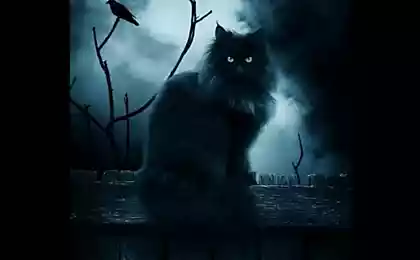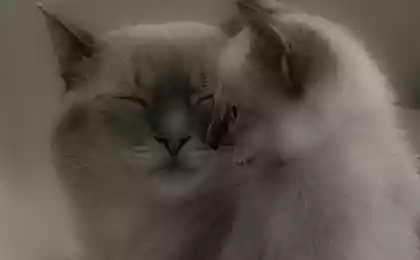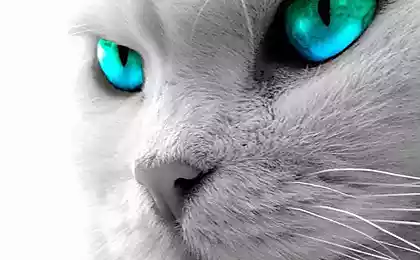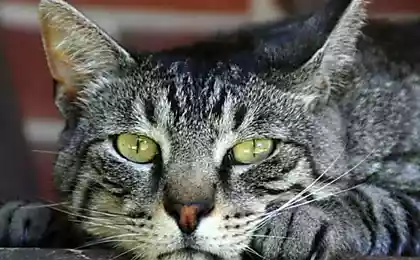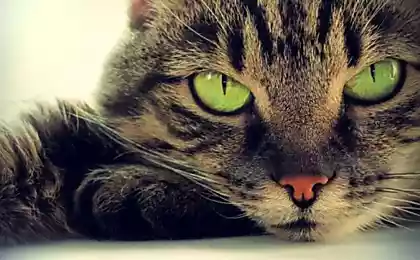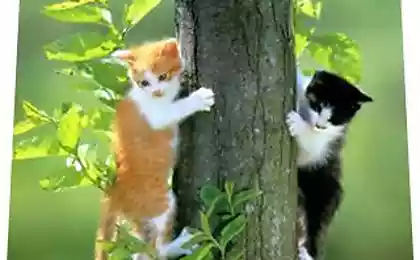846
Cat high-flying
Snow leopard or snow leopard - the rarest, unusual and mysterious beast of all the big cats. Only now, with the help of latest technology, scientists can uncover the mysteries of the life of the animal. If you have time before it is completely devoured by poachers.
The few shepherds and hunters, who were lucky to see the snow leopard in the wild, call him a ghost of the mountains. This smoky blue cat lives on hard rocky peaks. Just off the great famine irbis may attack livestock and prefers not to respond to human aggression aggression. In addition, unlike other big cats snow leopard can not roar.
Shooting the snow leopard in the wild - a rarity. These photos were taken in the national parks of Kyrgyzstan and Japan.
5 photos via goodnewsanimal

But this is not a sign of weakness, because the snow leopard lives in the harshest conditions and prey on animals three times larger than itself. "Local leopard afraid of foreigners more than the tiger because it is impossible to escape from the tree, as this beast perfectly climbs - wrote naturalist Nikolai Przewalski in 1860. - However, I have never heard of a leopard crushed somewhere in the Ussuri region of man, while the Tigers are doing it every year. While described the beast as it seems, enjoys the Golds and Orochi same worship as the tiger. At least these tribes meet with the image of idols and other animals. "
The snow leopard symbol of strength and power in many Asian nations, his picture is on the coats of arms of Tatarstan, Khakassia, Almaty, Bishkek and other regions and cities of Central Asia. Especially cynical total extermination of the snow leopard, which continues throughout the last half century, the Central Asian territory.
The main advantages of a leopard - the beauty and rarity - became his main curse. Luxury smoky-gray fur with dark spots on a leopard mask the background of rocks, but attracts poachers. Live snow leopards, as well as the skins of dead animals were favored government present in Central Asia: Kyrgyz president gave irbisovuyu coat once the president of Kazakhstan. In Kyrgyzstan, the hunting of the animal, which is included in all of the red book is still the traditional fun. On the territory of Kyrgyzstan in the recent past, poachers were killing up to 120 adult animals per year, and as many more babies were dying, deprived mothers because of those same poachers.

How many survived as a result of leopards, no one knows. The world population is estimated at 4000-6500 individuals. The actual number of species in Russia is now, according to the World Wildlife Fund (WWF), most likely not more than 70-90 individuals and the population is decreasing every year for a very rough estimate of 10 individuals. The snow leopard is endangered in all 12 countries of the habitat. He will survive or disappear in the next 10-15 years, it depends on the people.
Irbis is so elusive that a long time about his lifestyle and habits did not know almost nothing. Only in recent years, thanks to satellites, cameras, hardened snow leopard in the neck and placed in the reserves camera traps, scientists the opportunity to study these cats.
"We are happy as little children each found small things because it is of great interest for science - the director of the reserve" Khakassia "Victor Forgetful. - Our inspectors years go by the same trails where they know every rock, and then it turns out that on the same trails behind them goes leopard. This is an incredibly secretive animal. We have a saying: "You did not see a leopard, but he saw you exactly." Most scientists are not able to find the animal and its tracks and labels. This "evidence", as well as observing animals living in zoos, for a long time were the main sources of knowledge about the lifestyle and habits of cats.
How to hunt leopards
American writer and scientist George Schaller observed the life of wild animals in Tibet. Here is how he described the hunting of female leopard on grazing goats in the mountains of home: "She went down the slope; holding the body to the ground, carefully placing each paw. Reaching the stone above the place where there was a goat, she jumped down in a moment. " Podpolzanie It happened quickly, and the next time another cat creeping so slowly that the distance of 50 meters, it crept in only 10 minutes. All stalk lasted 45 minutes. "

Each leopard living on their own hunting area, the size of which depends on the abundance of food. For example, in Nepal, where there is no shortage of food in an area of 100 km2, it gets up to five animals. In other places, where there is less prey, five snow leopards can occupy together an area of 1,000 km2. In relation to their brethren snow leopards peaceful, try to avoid meeting each other and fight only in the mating season. Like other felines, they mark the boundaries of their land and the main trails mainly through smell.
Among the animals have enemies snow leopards there, so it's safe to walk on trails laid by other animals, allowing himself to be labeled in the same places that the wolves. Bypassing, leopard visited all known grazing large ungulates - ibex, argali, markhors and blue sheep. On starvation leopard can hunt for musk deer, roe deer, gazelle and wild boar, do not disdain even the hare or a marmot.
Leopard hunts usually in the evening. To apply as soon as possible and once a powerful blow to knock the victim down, he tries to climb the high stone or rock, and suddenly jump on prey from above. Overshot, snow leopard does not start in the chase, and once again sits in an ambush. With luck a leopard kill large ungulates every 10-15 days. After eating snow leopard, as any cat, long rests, washes, stretches and purrs.
On the trail it was found that a half-eaten carcass, he returned within a few days. Leopard on the hunt ground squirrels, marmots and mice has not been seen. For a long time it was thought that leopards eat only large ungulates, but by analyzing the feces revealed that their diet is much broader.
More details emerged from observations of animals in zoos. German researcher Helmut Hemmer described the characteristic facial expressions and posture leopard. He concluded that leopards can not roar. When learned to keep snow leopards in captivity, they began to produce offspring. And immediately there have been several studies detailing childbirth, behavior and relationships kids mother and kittens. The same Hemmer studied the game Young and compared the sounds that emit newborn kittens with grunting pigs and kittens two weeks sounds reminded him of the birds singing.

Female bears two to four cubs every two years, the male parenting does not participate. Helpless blind kittens the size of a domestic cat are born in the den, a mother happy in a cave or crevice in the rocks. Kittens are covered with thick brownish fur, entirely strewn with black spots. After a week and a half at them eyes open, five kittens start to leave the den to play on the surface. Since then, the mother begins to accustom them to the meat. Six-month kittens already go hunting with her learning to hunt down prey, sitting in ambush, stalking, and the only decisive shot female long the reserves. Completely independent of the mother's young are only a half or two years. Then they go in search of their own territory at great distances from the parent site, sometimes even moving across the plains to other mountain ranges.
Striving resettled away allows leopards reduce inbreeding, which would lead to the degeneration of the already small population. But it seriously complicates the study and conservation of leopards, because where it goes juveniles, remains a mystery. "Must take years and even decades of hard work, so we were able to say exactly how many snow leopards in Russia, - said the director of the reserve" Khakassia "Victor Forgetful. - Who is in the nature reserve on a regular basis are born and grow up kittens. And then what happens to them, where they go, we do not know ».
Traps for cats
Traditionally, leopards count of tracking, ie taking into account the tracks. This is a very difficult and inaccurate method. Today, to find out where and how to live snow leopards, and most importantly, how many of them there, the researchers tied to Leopard GPS-sensors and are arranged on their way camera traps. But so far, and with their help it is possible to find out little.
The work begins with the questioning of local residents. On the basis of personal data, researchers are planning an expedition, where leopards are looking for specific tracks, droppings and scratches. Further signs of life leopard scientists sent to the laboratory for genetic and hormonal analysis that can tell a lot about health, population, the ratio of males and females, young and old individuals. Take into account the most accurate snow leopards allow camera traps - concealed automatic camera movement deliverers.
Camera traps should be placed where the animal will be required to, for example, next to the trees and the stones on which the leopards mark their territory.

PhotoHunt to snow leopards
These pictures are made of photographic devices installed in the Reserve "Sayano-Shushenskaya" and "Khakassia" with the support of the Russian Geographical Society. The Russian photography in the snow leopard is conducted since 2008, the RGS supports programs for the conservation and study of snow leopards. In 2011, the Company has provided a grant for the expedition "Following the snow leopard", and in 2012 funded the project, which is a continuation of the expedition and named "Wild cats in Southern Siberia." At this time, the object of the research was not only the snow leopard, and other members of the feline, endangered - and Pallas' cat lynx.
When accumulated sufficient database of photos, you can recognize all the animals got into the camera traps, by the pattern of spots and other signs. As a result, unable to count them, and make detailed for each passport. "The first images we received in 2008, before the general knew almost nothing - says Gennady Kiselev, director of the Sayano-Shushenskoye Reserve. - Now, thanks to accumulation of human resources, we know in the face of all the animals living in the reserve, their sites and habits, age and state of health of each. A total of nine, a few come here during the rut ».
Last year, researchers at the Sayano-Shushenskoye Reserve using satellite collars began to follow the movements of the snow leopard named Mongol. "To catch the animals, scientists have placed special zhivolovushki, which had been hidden camera - says Viktor Forgetful. - The calculation was normal feline curiosity. And it worked! Bars back to check, however, I did not want to go. Then, in place of its traditional path set foot loop with beacons. When the beast was caught, his sedated by a syringe-dart filled with tranquilizer. The scientists measured the weight, height, took blood samples and hair of a sleeping cat, a little podlechil it, put the collar and released ».
The collar was to help understand how the leopard lives, what his relationship with relatives, what distance it travels. Unfortunately, new data managed to get a little bit because it appeared that the Mongol researchers already know of camera traps. Mongol lives in their area (20 hectares Ltd.) in the reserve on the left bank of the Yenisei River and beyond the territory does not come out. In addition, the collar did not last long: the leopard smashed it on the rocks.
Unnatural selection
Poachers hunt mainly fur (still on the Internet you can find ads for the sale of skins for 5-10 thousand dollars), as well as bones and claws of the snow leopard, which eastern healers used in diseases of the joints. Farm animals leaves very little food for the wild sheep and goats, their number reduced, and hungry leopards begin to attack the pet, so herders believe Barca your enemy and try to destroy. Hinges, more wire rings, poachers are hung at a height of animal in the narrow passages and crevices. Once in the loop head, the beast trying to break out of the stranglehold, jerks and pulls himself. Nobody knows exactly how many snow leopards are killed by poachers: the territory of the reserves of such cases do not happen, and the outside is almost impossible to follow.
Snow leopards suffer from habitat destruction: roads, mining - all this sharply reduces the area suitable for snow leopards. In addition, although hunting them is forbidden in the countries they live poorly enforced law. A third of the habitat of the snow leopard, and all falls on the border and disputed territory, where there is war - Afghanistan, Kashmir, Tajikistan and Nepal - that too is not conducive to the safety of the snow leopard. All that remains environmentalists - is to educate locals and create new nature reserves.
Many environmental funds insure livestock against attacks by leopards and help develop ecological tourism, which becomes the hunter an alternative source of income. According to the WWF, as a result of this work in recent years, unable to stop the decline in the main groups of the snow leopard. That is, it is hoped that the leopard will survive.
"Around the World" in August 2012
Source:
The few shepherds and hunters, who were lucky to see the snow leopard in the wild, call him a ghost of the mountains. This smoky blue cat lives on hard rocky peaks. Just off the great famine irbis may attack livestock and prefers not to respond to human aggression aggression. In addition, unlike other big cats snow leopard can not roar.
Shooting the snow leopard in the wild - a rarity. These photos were taken in the national parks of Kyrgyzstan and Japan.
5 photos via goodnewsanimal

But this is not a sign of weakness, because the snow leopard lives in the harshest conditions and prey on animals three times larger than itself. "Local leopard afraid of foreigners more than the tiger because it is impossible to escape from the tree, as this beast perfectly climbs - wrote naturalist Nikolai Przewalski in 1860. - However, I have never heard of a leopard crushed somewhere in the Ussuri region of man, while the Tigers are doing it every year. While described the beast as it seems, enjoys the Golds and Orochi same worship as the tiger. At least these tribes meet with the image of idols and other animals. "
The snow leopard symbol of strength and power in many Asian nations, his picture is on the coats of arms of Tatarstan, Khakassia, Almaty, Bishkek and other regions and cities of Central Asia. Especially cynical total extermination of the snow leopard, which continues throughout the last half century, the Central Asian territory.
The main advantages of a leopard - the beauty and rarity - became his main curse. Luxury smoky-gray fur with dark spots on a leopard mask the background of rocks, but attracts poachers. Live snow leopards, as well as the skins of dead animals were favored government present in Central Asia: Kyrgyz president gave irbisovuyu coat once the president of Kazakhstan. In Kyrgyzstan, the hunting of the animal, which is included in all of the red book is still the traditional fun. On the territory of Kyrgyzstan in the recent past, poachers were killing up to 120 adult animals per year, and as many more babies were dying, deprived mothers because of those same poachers.

How many survived as a result of leopards, no one knows. The world population is estimated at 4000-6500 individuals. The actual number of species in Russia is now, according to the World Wildlife Fund (WWF), most likely not more than 70-90 individuals and the population is decreasing every year for a very rough estimate of 10 individuals. The snow leopard is endangered in all 12 countries of the habitat. He will survive or disappear in the next 10-15 years, it depends on the people.
Irbis is so elusive that a long time about his lifestyle and habits did not know almost nothing. Only in recent years, thanks to satellites, cameras, hardened snow leopard in the neck and placed in the reserves camera traps, scientists the opportunity to study these cats.
"We are happy as little children each found small things because it is of great interest for science - the director of the reserve" Khakassia "Victor Forgetful. - Our inspectors years go by the same trails where they know every rock, and then it turns out that on the same trails behind them goes leopard. This is an incredibly secretive animal. We have a saying: "You did not see a leopard, but he saw you exactly." Most scientists are not able to find the animal and its tracks and labels. This "evidence", as well as observing animals living in zoos, for a long time were the main sources of knowledge about the lifestyle and habits of cats.
How to hunt leopards
American writer and scientist George Schaller observed the life of wild animals in Tibet. Here is how he described the hunting of female leopard on grazing goats in the mountains of home: "She went down the slope; holding the body to the ground, carefully placing each paw. Reaching the stone above the place where there was a goat, she jumped down in a moment. " Podpolzanie It happened quickly, and the next time another cat creeping so slowly that the distance of 50 meters, it crept in only 10 minutes. All stalk lasted 45 minutes. "

Each leopard living on their own hunting area, the size of which depends on the abundance of food. For example, in Nepal, where there is no shortage of food in an area of 100 km2, it gets up to five animals. In other places, where there is less prey, five snow leopards can occupy together an area of 1,000 km2. In relation to their brethren snow leopards peaceful, try to avoid meeting each other and fight only in the mating season. Like other felines, they mark the boundaries of their land and the main trails mainly through smell.
Among the animals have enemies snow leopards there, so it's safe to walk on trails laid by other animals, allowing himself to be labeled in the same places that the wolves. Bypassing, leopard visited all known grazing large ungulates - ibex, argali, markhors and blue sheep. On starvation leopard can hunt for musk deer, roe deer, gazelle and wild boar, do not disdain even the hare or a marmot.
Leopard hunts usually in the evening. To apply as soon as possible and once a powerful blow to knock the victim down, he tries to climb the high stone or rock, and suddenly jump on prey from above. Overshot, snow leopard does not start in the chase, and once again sits in an ambush. With luck a leopard kill large ungulates every 10-15 days. After eating snow leopard, as any cat, long rests, washes, stretches and purrs.
On the trail it was found that a half-eaten carcass, he returned within a few days. Leopard on the hunt ground squirrels, marmots and mice has not been seen. For a long time it was thought that leopards eat only large ungulates, but by analyzing the feces revealed that their diet is much broader.
More details emerged from observations of animals in zoos. German researcher Helmut Hemmer described the characteristic facial expressions and posture leopard. He concluded that leopards can not roar. When learned to keep snow leopards in captivity, they began to produce offspring. And immediately there have been several studies detailing childbirth, behavior and relationships kids mother and kittens. The same Hemmer studied the game Young and compared the sounds that emit newborn kittens with grunting pigs and kittens two weeks sounds reminded him of the birds singing.

Female bears two to four cubs every two years, the male parenting does not participate. Helpless blind kittens the size of a domestic cat are born in the den, a mother happy in a cave or crevice in the rocks. Kittens are covered with thick brownish fur, entirely strewn with black spots. After a week and a half at them eyes open, five kittens start to leave the den to play on the surface. Since then, the mother begins to accustom them to the meat. Six-month kittens already go hunting with her learning to hunt down prey, sitting in ambush, stalking, and the only decisive shot female long the reserves. Completely independent of the mother's young are only a half or two years. Then they go in search of their own territory at great distances from the parent site, sometimes even moving across the plains to other mountain ranges.
Striving resettled away allows leopards reduce inbreeding, which would lead to the degeneration of the already small population. But it seriously complicates the study and conservation of leopards, because where it goes juveniles, remains a mystery. "Must take years and even decades of hard work, so we were able to say exactly how many snow leopards in Russia, - said the director of the reserve" Khakassia "Victor Forgetful. - Who is in the nature reserve on a regular basis are born and grow up kittens. And then what happens to them, where they go, we do not know ».
Traps for cats
Traditionally, leopards count of tracking, ie taking into account the tracks. This is a very difficult and inaccurate method. Today, to find out where and how to live snow leopards, and most importantly, how many of them there, the researchers tied to Leopard GPS-sensors and are arranged on their way camera traps. But so far, and with their help it is possible to find out little.
The work begins with the questioning of local residents. On the basis of personal data, researchers are planning an expedition, where leopards are looking for specific tracks, droppings and scratches. Further signs of life leopard scientists sent to the laboratory for genetic and hormonal analysis that can tell a lot about health, population, the ratio of males and females, young and old individuals. Take into account the most accurate snow leopards allow camera traps - concealed automatic camera movement deliverers.
Camera traps should be placed where the animal will be required to, for example, next to the trees and the stones on which the leopards mark their territory.

PhotoHunt to snow leopards
These pictures are made of photographic devices installed in the Reserve "Sayano-Shushenskaya" and "Khakassia" with the support of the Russian Geographical Society. The Russian photography in the snow leopard is conducted since 2008, the RGS supports programs for the conservation and study of snow leopards. In 2011, the Company has provided a grant for the expedition "Following the snow leopard", and in 2012 funded the project, which is a continuation of the expedition and named "Wild cats in Southern Siberia." At this time, the object of the research was not only the snow leopard, and other members of the feline, endangered - and Pallas' cat lynx.
When accumulated sufficient database of photos, you can recognize all the animals got into the camera traps, by the pattern of spots and other signs. As a result, unable to count them, and make detailed for each passport. "The first images we received in 2008, before the general knew almost nothing - says Gennady Kiselev, director of the Sayano-Shushenskoye Reserve. - Now, thanks to accumulation of human resources, we know in the face of all the animals living in the reserve, their sites and habits, age and state of health of each. A total of nine, a few come here during the rut ».
Last year, researchers at the Sayano-Shushenskoye Reserve using satellite collars began to follow the movements of the snow leopard named Mongol. "To catch the animals, scientists have placed special zhivolovushki, which had been hidden camera - says Viktor Forgetful. - The calculation was normal feline curiosity. And it worked! Bars back to check, however, I did not want to go. Then, in place of its traditional path set foot loop with beacons. When the beast was caught, his sedated by a syringe-dart filled with tranquilizer. The scientists measured the weight, height, took blood samples and hair of a sleeping cat, a little podlechil it, put the collar and released ».
The collar was to help understand how the leopard lives, what his relationship with relatives, what distance it travels. Unfortunately, new data managed to get a little bit because it appeared that the Mongol researchers already know of camera traps. Mongol lives in their area (20 hectares Ltd.) in the reserve on the left bank of the Yenisei River and beyond the territory does not come out. In addition, the collar did not last long: the leopard smashed it on the rocks.
Unnatural selection
Poachers hunt mainly fur (still on the Internet you can find ads for the sale of skins for 5-10 thousand dollars), as well as bones and claws of the snow leopard, which eastern healers used in diseases of the joints. Farm animals leaves very little food for the wild sheep and goats, their number reduced, and hungry leopards begin to attack the pet, so herders believe Barca your enemy and try to destroy. Hinges, more wire rings, poachers are hung at a height of animal in the narrow passages and crevices. Once in the loop head, the beast trying to break out of the stranglehold, jerks and pulls himself. Nobody knows exactly how many snow leopards are killed by poachers: the territory of the reserves of such cases do not happen, and the outside is almost impossible to follow.
Snow leopards suffer from habitat destruction: roads, mining - all this sharply reduces the area suitable for snow leopards. In addition, although hunting them is forbidden in the countries they live poorly enforced law. A third of the habitat of the snow leopard, and all falls on the border and disputed territory, where there is war - Afghanistan, Kashmir, Tajikistan and Nepal - that too is not conducive to the safety of the snow leopard. All that remains environmentalists - is to educate locals and create new nature reserves.
Many environmental funds insure livestock against attacks by leopards and help develop ecological tourism, which becomes the hunter an alternative source of income. According to the WWF, as a result of this work in recent years, unable to stop the decline in the main groups of the snow leopard. That is, it is hoped that the leopard will survive.
"Around the World" in August 2012
Source:
